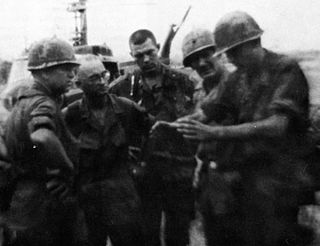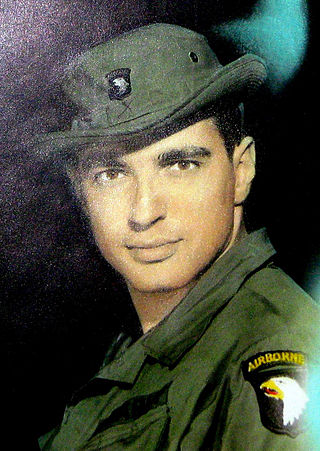
The Americal Division was an infantry division of the United States Army during World War II and the Vietnam War.

The Tet Offensive was a major escalation and one of the largest military campaigns of the Vietnam War. The Viet Cong (VC) and North Vietnamese People's Army of Vietnam (PAVN) launched a sneak attack on January 30, 1968, against the forces of the South Vietnamese Army of the Republic of Vietnam (ARVN), the United States Armed Forces and their allies. It was a campaign of surprise attacks against military and civilian command and control centers throughout South Vietnam. The name is the truncated version of the Lunar New Year festival name in Vietnamese, Tết Nguyên Đán, with the offense chosen during a holiday period as most ARVN personnel were on leave. The purpose of the wide-scale offensive by the Hanoi Politburo was to trigger political instability, in a belief that mass armed assault on urban centers would trigger defections and rebellions.

The Battle of Khe Sanh was conducted in the Khe Sanh area of northwestern Quảng Trị Province, Republic of Vietnam, during the Vietnam War. The main US forces defending Khe Sanh Combat Base (KSCB) were two regiments of the United States Marine Corps supported by elements from the United States Army and the United States Air Force (USAF), as well as a small number of Army of the Republic of Vietnam (ARVN) troops. These were pitted against two to three divisional-size elements of the North Vietnamese People's Army of Vietnam (PAVN).

The battle of Dak To in Vietnam was a series of major engagements of the Vietnam War that took place between 3 and 23 November 1967, in Kon Tum Province, in the Central Highlands of the Republic of Vietnam. The action at Đắk Tô was one of a series of People's Army of Vietnam (PAVN) offensive initiatives that began during the second half of the year. PAVN attacks at Lộc Ninh, Sông Bé and at Con Thien and Khe Sanh,, were other actions which, combined with Đắk Tô, became known as "the border battles". The post hoc purported objective of the PAVN forces was to distract American and South Vietnamese forces away from cities towards the borders in preparation for the Tet Offensive.

The 11th Armored Cavalry Regiment is a unit of the United States Army garrisoned at the Fort Irwin National Training Center in California. The regiment has served in the Philippine–American War, the Pancho Villa Expedition, World War II, the Vietnam War, Gulf War and Iraq War. The 11th ACR serves as the opposing force (OPFOR) for the Army and Marine task forces, and foreign military forces that train at Fort Irwin.

The 3rd United States Infantry Regiment is a regiment of the United States Army. It currently has three active battalions, and is readily identified by its nickname, The Old Guard, as well as Escort to the President. The regimental motto is Noli Me Tangere. The regiment is a major unit of the Military District of Washington (MDW).

Dale Adam Dye Jr. is an American actor, technical advisor, radio personality and writer. A decorated Marine veteran of the Vietnam War, Dye is the founder and head of Warriors, Inc., a technical advisory company specializing in portraying realistic military action in Hollywood films. Dye has also offered his expertise to television, such as the HBO miniseries Band of Brothers and The Pacific, and video games, including the Medal of Honor series.

Joe Ronnie Hooper was an American who served in both the United States Navy and United States Army where he finished his career there as a captain. He earned the Medal of Honor while serving as an army staff sergeant on February 21, 1968, during the Vietnam War. He was one of the most decorated U.S. soldiers of the war and was wounded in action eight times.

Con Thien was a military base that started out as a U.S. Army Special Forces camp before transitioning to a United States Marine Corps combat base. It was located near the Vietnamese Demilitarized Zone (DMZ) about 3 kilometers (1.9 mi) from North Vietnam in Gio Linh District, Quảng Trị Province. It was the site of fierce fighting from February 1967 through February 1968.

The Battle of Ong Thanh was fought at the stream of that name on the morning of 17 October 1967, in Chơn Thành District, at the time part of Bình Dương Province, South Vietnam, today in Bình Phước Province.

The First Battle of Saigon, fought during the Tet Offensive of the Vietnam War, was the coordinated attack by communist forces, including both the North Vietnamese Army and the Viet Cong (VC), against Saigon, the capital of South Vietnam.

The Battle of Huế, also called the siege of Huế, was a major military engagement in the Tết Offensive launched by North Vietnam and the Việt Cộng during the Vietnam War. After initially losing control of most of Huế and its surroundings, the combined South Vietnamese and American forces gradually recaptured the city over one month of intense fighting. The battle was one of the longest and bloodiest of the war, and the battle negatively affected American public perception of the war.

Operation Wheeler/Wallowa was a U.S. offensive operation during the Vietnam War, launched on 11 September 1967 as two separate operations and concluding in November 1968. Initially named as Operation Wheeler and Wallowa, this was merged in November 1967 as Wheeler/Wallowa. The operation was at first conducted by the 101st Airborne Division and 1st Cavalry Division, but it was progressively taken over by 23rd Infantry (Americal) Division.

The Battle of Kham Duc was a major battle of the Vietnam War. The event occurred in Khâm Đức, now district capital of Khâm Đức District, then in Quảng Tín Province, from 10–12 May 1968. During the Tet Offensive of 1968, the People's Army of Vietnam (PAVN) 2nd Division tried to capture Đà Nẵng, but they were defeated in the Battle of Lo Giang by elements of the U.S. 1st Marine Division and the 23rd Infantry Division. PAVN General Chu Huy Mân disengaged from the fight on the outskirts of the city, and pulled the 2nd Division into the mountains to rest, rebuild, and prepare for the next major operation. The US and allied defenders of the Special Forces camp at Khâm Đức, a small district in the north of Quảng Tín, were chosen as the next target for the 2nd Division. Although the Special Forces camp had never been an obstacle to the constant infiltration of PAVN troops around it, the North Vietnamese hoped to attract major US reinforcements away from the lowland populated areas, kill or capture them and film the battle, presumably to make it look like a US Điện Biên Phủ on the eve of the 1st Paris peace conference.

The 52nd Infantry Regiment is an infantry regiment of the United States Army.

The New Year's Day battle of 1968 was a military engagement during the Vietnam War in Tây Ninh province that began on the evening of 1 January 1968. It involved units assigned to the U.S. 25th Infantry Division and two regiments of the People's Army of Vietnam (PAVN). The battle was known as the Battle of Fire Support Base Burt, or the Battle of Suoi Cut. This is not the same location as Suối Cắt village in northern Vietnam.

Leslie Halasz Sabo Jr. was a soldier in the United States Army during the Vietnam War. He received the highest military decoration, the Medal of Honor, for his actions during the Cambodian Campaign in 1970.
Company E, 52nd Infantry, (LRP) was a 120 man-sized long-range reconnaissance patrol unit attached to the 1st Cavalry Division (Airmobile) in Vietnam in 1967-69. Its origin begins on January 1, 1967, as "LRRP Detachment G2," 1st Cavalry Division (Airmobile). It was then redesignated "Headquarters & Headquarters Company LRRP Detachment" in April 1967, and redesignated "Company E, 52nd Infantry (LRP)" on December 20, 1967.
The Battle of Landing Zone Center took place from 5–25 May 1968 in Quảng Tín Province during the Vietnam War.

The Battle of Bà Rịa took place from January 31 to February 7, 1968 in Phước Tuy province, South Vietnam. It occurred as part of the Tet Offensive, with large formations of Viet Cong troops attacking allied forces consisting of South Vietnamese, Australian and American troops. The Australians engaged in the heaviest street fighting seen by any of their units during the war, and the attack was defeated with heavy casualties inflicted on the VC.

















